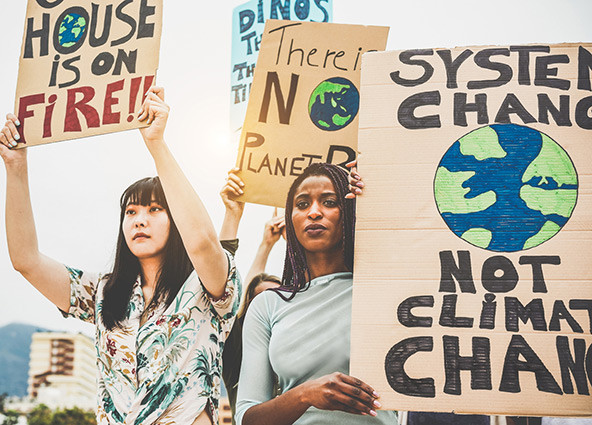 (Photo by iStock/DisobeyArt)
(Photo by iStock/DisobeyArt)
In Fall 2020, the COVID-19 pandemic and mass mobilizations against systemic racism create an array of new challenges for colleges and universities that prioritize social innovation. Middlebury is one of them. For decades, faculty committed to research- and project-based learning and staff in our Center for Community Engagement, and elsewhere on campus, have prepared students to address the world’s most challenging problems. Over the last ten years, Middlebury further expressed its commitment to help students become innovators through its designation as an Ashoka U Changemaker Campus in 2011 and the creation of a center for social entrepreneurship (now the Innovation Hub) in 2012. Like universities and colleges everywhere, we now find ourselves challenged to help students attend to the reverberations of the global pandemic and, in the words of President Laurie Patton, “to center our work on the anti-Black racism that permeates our lives.” Our students, led by our Black students, demand no less.
To meet the challenge, we are tapping into Middlebury’s culture of collaborative, student-centric innovation. In our rural Vermont landscape, “The Strength of the Hills”—as inscribed on the college’s Mead Chapel—has always framed our commitment to innovation, and since 1965, our Environmental Studies students have studied the diverse human-environment relationships in the unique clayplain forest of the Champlain Valley. But the educational ecosystem that Middlebury faculty and staff have created over the last two decades is not place dependent: the key is that our primary agent of change is the student.

This approach—call it “open-source learning”—builds on the essence of the liberal arts: to be liberated and free of prior constraints. Middlebury’s innovation is to give our students permission—or teach them to “give themselves permission,” following the ethos of Ashoka’s Bill Drayton—to pursue bold, audacious goals for the common good. In the spirit of John Dewey’s vision of the civic purpose of education—“that education is the fundamental method of social progress and reform”—we challenge our students to work not only in small groups in the classroom, but via networks outside of the classroom in order to create knowledge with the potential of worldwide, systemic impact.
The story of 350.org exemplifies this ethos: in 2007, Middlebury students led a successful campaign for the college to achieve carbon neutrality within a decade. In 2008, seven of those students co-founded 350.org with Bill McKibben, Middlebury’s Schumann Distinguished Scholar in Residence in Environmental Studies, and—in partnership with a range of environmental and justice organizations—this global NGO has gone on to be at the forefront of the global climate movement for a rapid, just transition to 100% renewable energy for all. According to May Boeve, 350.org’s executive director, she and the other alumni co-founders continue to use organizing skills honed at Middlebury: learning how to work together, connecting with leaders elsewhere, and iteratively sorting out what works to take on the great challenges of our time.
The latest outcome of Middlebury’s student-centric process of innovation is Energy2028: an ambitious plan for Middlebury to “transition to 100 percent renewable energy sources for our core Vermont campus” by using renewable natural gas, investing in solar, and reducing energy consumption by 25 percent. As part of Energy2028, Middlebury’s board approved the phaseout of direct fossil fuel investments in its endowment, the culmination of a multi-year campaign by students.
The process of getting to Energy2028 was a two-decade collaboration among a diverse set of actors. Several generations of students organized and pushed administrators to accelerate Middlebury’s sustainability initiatives. President Ronald Liebowitz, followed by President Patton, encouraged students to assemble and analyze data in order to engage Middlebury’s Board of Trustees; Nan Jenks-Jay, Dean of Environmental Affairs, and Jack Byrne, Middlebury’s Director of Sustainability Integration, provided resources and counsel for the students to do so. Environmental Studies faculty laid the groundwork, teaching within and across disciplines (e.g., political science, chemistry, and creative non-fiction) and giving students the freedom to engage in independent research, collaborate with community members, and consult with external experts.
Four lessons from that multi-year process are likely to help leaders at Middlebury—and, I believe, at other institutions—to navigate the years ahead as the world rebuilds after COVID-19 and the United States recommits to reckoning with its legacy of systemic racism.
1. Convert Fear and Anger Into Action
In 2005, a handful of Middlebury students, inspired by the open-source methodology in a recent course about building the new climate movement, started “The Sunday Night Environmental Group” (SNEG), a student-led collective designed to build climate solutions. This group not only began the planning for Middlebury’s carbon-neutral campaign but also the subsequent push for divestment that became a pillar of Energy2028. Over time, SNEG members have learned—and pass on to new generations of students—what works: how to identify the key on-campus leaders and decision-makers, what framing will appeal to the administration and board, and how to build coalitions around common visions of justice.
Innovation can flow from outrage. College students well-versed in the science and frustrating politics of global warming fear that most of their adult lives will be dominated by the existential threat of climate change. Angry at the world around them, they view the climate crisis as a manifestation of a system of injustices that have held back indigenous and marginalized communities and perpetuated poverty. On campuses that prioritize innovation, students must be encouraged to take action and test solutions, building on but also transcending the theories they have learned in the classroom. When faculty and staff teach the power of pragmatism and then open up time and space for their students to test ideas, they learn the gritty habits of planning, organization, mobilization, and assessment.
2. Invert the Hierarchy
In 2012, as 350.org planned to launch a global push for divestment, Middlebury students launched their own campaign. At this stage, it was not successful, despite a series of negotiations and public hearings overseen by President Ronald Leibowitz: in 2013, the Middlebury board voted to not divest. But the students’ concerns were weighed with care and respect, and President Liebowitz gave students access to his administrators and the college board. In fact, during his presidency, he advocated for students as the most credible agents of institutional change.
Like most sectors, higher education is defined by hierarchy: professors with PhDs teach students aspiring to earn their first degree; boards of directors, based on their fiduciary responsibility, oversee administrators. But to commit to student-centric innovation, leaders must put aside the formal elements of hierarchy and welcome students to the table. To do so, academics need to unlearn the maxim that students must always be taught. If we treat them with respect, they can join us and help to lead.
3. Coordinate Learning Inside and Outside of the Classroom
In 2017, a new cohort of Middlebury students renewed the divestment campaign at Middlebury, inspired by the growing success of the fossil-fuel divestment movement worldwide. In January 2018, a subset of those students enrolled in the Sustainability Solutions Lab, a four-week course taught by Jack Byrne that was designed to help the college transition to 100% renewable energy sources and significantly reduce consumption. In Fall 2018, with the encouragement of President Patton and her administrative team, students worked closely with staff and faculty at Middlebury’s Franklin Environmental Center to streamline divestment and sustainability efforts. By the end of the fall semester, the details for Energy2028 were in place, including a commitment to divestment and an educational component “to address today’s most challenging problems in meaningful ways.” Since then, the Middlebury administration has encouraged more faculty to embrace project-based learning, sponsoring a range of related workshops and presentations.
In a residential undergraduate institution, learning outside of the classroom can enhance traditional coursework. Faculty should commit to a pedagogy that inclusively engages students in problem-solving and applied learning opportunities and then encourage their students to complement their coursework with extra- and co-curricular activities. Administrators should provide space and resources for students to do so, offering support for students to use the classroom to address challenges on campus and co-create innovative solutions. Students who receive such support can then harness their energy, ideas, and time to be the agents of campus-wide innovation. Faculty tied to more traditional models of education may not gravitate to such an approach: for many scholars, research (in which undergraduates are junior partners) is the fundamental foundation for learning. Leaders of institutions that value innovation, while maintaining support for research-based pedagogy, should provide incentives to faculty (e.g., in promotion decisions) who support student-centered learning that transcends the classroom walls.
4. Above All, Teach Empathy
In the run-up to the Middlebury board’s approval of Energy 2028 in early 2019, students met with board members to make the case for divestment. During this process, Middlebury’s CFO David Provost guided the students with care: he emphasized the need to listen to board members, to acknowledge the power of their counter-arguments. This strategy worked. Board members and students were able to build bonds of trust and find common ground in the Energy2028 plan being finalized by President Patton and her team.
Undergraduates who seek social change are often impatient; at their worst they are self-righteous. When faculty teach theory based on narrow disciplinary models, students can get locked into a single worldview about social change; by contrast, teaching social innovation deemphasizes ideology, and puts a premium on the power of listening. Ashoka’s decades-long advocacy of teaching empathy remains a cornerstone for this approach. When students are taught to slow down and acknowledge the points of view of others, they can begin better to build coalitions for change.
A Blueprint for an Uncertain Future
The forthcoming academic year is uncharted terrain. The pandemic is unlikely to subside until a vaccine is widely available, and the American public’s support for the Black Lives Matter movement has the potential to spark long-overdue societal change. To move forward, Middlebury’s recent experience with Energy2028 suggests a blueprint for institutions committed to innovation:
- Begin by acknowledging that our students will return to campus with anxiety, anger, and resolve.
- Be ready to listen in new ways, especially to Black students, as they reflect on their identities, push for structural change, and discover the power of their agency in these troubled times.
- Be ready to help them to take action by rethinking our curricula and offering new opportunities to engage, on- and off-campus.
Finally, we must recommit to teaching the power of empathy: as we look with humility toward the second half of 2020, perhaps the only certainty is that people everywhere will need compassion and understanding. If we get it right, our students can, with urgency, help us build the beloved communities for the future.
Support SSIR’s coverage of cross-sector solutions to global challenges.
Help us further the reach of innovative ideas. Donate today.
Read more stories by Jonathan Isham.

